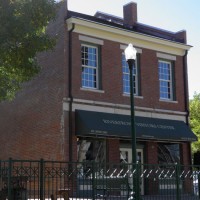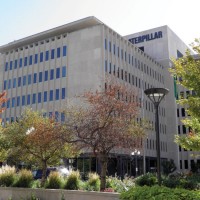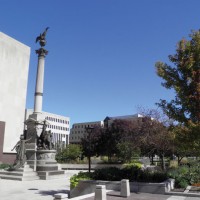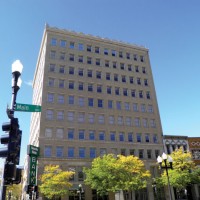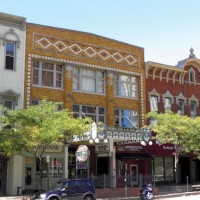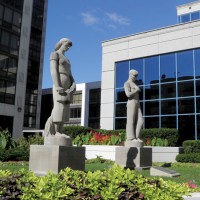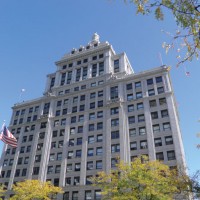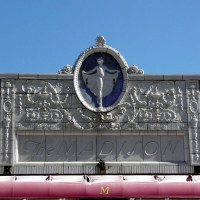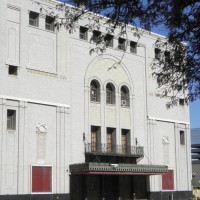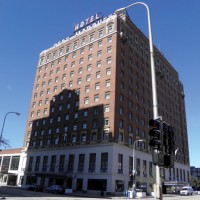Voices
Peoria's Surprising Architecture
- Details
- Published on Tuesday, 01 November 2011 13:42
- Written by Dr. Peter J. Couri
Upcoming issues of The Peorian will feature walking tours of Peoria's more interesting areas. This issue is the first of three parts about Downtown Peoria.
French explorers settled among the native peoples here in 1691 to start Illinois' oldest European settlement. The French villages here lasted for 120 years until the French and native peoples were forcibly removed by American soldiers during the War of 1812. The American soldiers then built Fort Clark in 1813. You can walk one block south of Main Street to Liberty Street where a pavilion containing a historic marker commemorates the founding of Fort Clark with French, British, Spanish, and American flags flying.
Our tour begins here at...
1. JOHN SCHWAB'S GROCERY & BEER SALOON (RIVERFRONT VISITORS CENTER)
110 N.E. Water Street
Main Street and the River has always been the main boat landing for Downtown and it is here you will find the Riverfront Visitors Center. It is the oldest commercial building left in Downtown Peoria and is an excellent example of early American architectural style.
During the 1850s, Peoria absorbed a large number of German immigrants. One of them was John Schwab and he built this building in 1852 as a grocery on one side, a beer saloon on the other. He and his daughters lived in the upper stories. You could purchase a dish of ice cream for 15 cents or get a beer for a nickel.
Proceed up Main Street... and you can see the construction of Museum Square where the new Caterpillar Visitor Center and the Peoria Riverfront Museum with its planetarium and large screen theater will be a welcome addition to the vibrant central city. Their abstract designs of shimmering silver metallic sheets and glass panes will make them instant landmarks.
Continuing at Main and Adams is...
2. CATERPILLAR WORLD HEADQUARTERS
100 N.E. Adams Street
Caterpillar is the world's leading manufacturer of construction and mining equipment, diesel and natural gas engines, industrial gas turbines, and diesel-electric locomotives. It is a Fortune 100 company with over 200,000 employees worldwide.
They have been located in the Peoria area since 1909. Their modern-style world headquarters was opened in 1968. The pristine limestone reflects other surrounding buildings, including the courthouse, which were all part of what was called the "Downtown Renaissance" of the 1960s, where whole blocks of old buildings were cleared for urban renewal.
The main lobby is richly appointed with travertine marble, woodbury granite, and safari granite. The peaceful formal gardens around the building were designed by Thomas Church. Around them flags fly from many of the nations that manufacture Caterpillar products.
Cross Adams St. to the...
3. PEORIA COUNTY COURTHOUSE & PLAZA
324 Main Street
This entire block has always been the Peoria County Courthouse block since the first Peoria streets were laid out by William Hamilton, Alexander Hamilton's oldest son in 1825. A two-story courthouse with four massive pillars was built in 1832. Abraham Lincoln and Stephen Douglas spoke from its balcony many times.
In 1876, a grand Venetian-style courthouse was erected with a massive bell and clock tower. You can find the bell resting in the plaza now and the clock will be keeping time in the new history museum. This courthouse was demolished in 1962 to give rise to the modern limestone structure you see today. Lady Bird Johnson dedicated the courthouse plaza by planting a cherry tree in 1965 as a major part of her American beautification project.
The Civil War memorial in the plaza was designed by Peoria born sculptor Fritz Triebel. The artistry of the sculptures on the memorial is considered some of the finest in the nation. The bronze soldiers are defending the flag with the valor and the horror of war vividly portrayed. The classic heroic figure of "History" writes "We write on page of granite what they wrought on field of battle." Atop the granite shaft of the monument sits "Old Abe the War Eagle." Old Abe was the mascot of the 8th Wisconsin Volunteer Infantry Regiment and they never lost a battle with him there. Old Abe visited Peoria in 1866 and was paraded up and down the streets to much fanfare for three solid hours.
Cross Main St. to the...
4. CENTRAL NATIONAL BANK BUILDING
(SOUTH SIDE BANK)
103 S.W. Adams Street
The Central National Bank Building is a textbook example of the Chicago School of Architecture as well it should be because it was designed by famous Chicago architect Daniel Burnham. He was the architect of the 1893 Chicago World's Fair and the urban designer of the Chicago Plan for Lake Shore Drive and Grant Park in 1909.
He built Peoria's Central National Bank building in 1914 with his classic Renaissance revival style. Notice the beautiful terra cotta cornices and the acanthus leaf design moldings lining the roof.
Next door is the...
5. APOLLO THEATER
311 S. Main Street
The Apollo Theater began showing silent movies in 1914. At the time, there were 14 major theaters in Peoria where stage shows and vaudeville enjoyed much success. The Apollo became the first Peoria theater devoted solely to motion pictures. It closed in 1958 and the ground floor was demolished for a parking deck. In 1990, attorney Tom Leiter discovered the balcony was in fine shape and had it restored into a small theater which still delights audiences today.
Walk down the block and cross Jefferson St. to the...
6. PEACE & HARVEST STATUES
401 Main Street
Watching over the Becker Building plaza are two 8 foot limestone statues called Peace and Harvest. They were sculpted by Peorian Mary Andersen Clark in 1939 as part of the Works Progress Administration Federal Art Project. The art-deco style male figure is "Peace" and woman figure is "Harvest" and they express the artist's love of Midwestern values. They are the largest and considered the finest outdoor WPA sculptures in the nation.
Cross Main St. to the...
7. PEORIA LIFE INSURANCE BUILDING (COMMERCE BANK BUILDING)
416 Main Street
Built in 1920, this skyscraper is sheathed in white terra-cotta, with classical embellishments, majestic American eagles, and sentinels guarding the entrances. But it is the lantern tower atop the building that gives Peoria its distinctive skyline. It was placed there to guard against a new and growing problem in 1920 – low flying bi-planes.
Continue walking up Main St. to...
8. MADISON THEATRE
502 Main Street
This is Peoria's last remaining grand theater. It was designed by Peoria architect Frederick Klein in 1920. He built grand ornate theater palaces across the Midwest. The Madison is considered his masterpiece. The Italian Renaissance inspired exterior with its white terra cotta relief gives way to a refined understated interior of gold and cream details inspired by the palaces of England. The auditorium ceiling is an exquisitely beautiful dome of concentric circles, garlands, and rosettes.
Notice the delicate art nouveau medallion, commonly called the "Madison Maiden," that overlooks the Main Street side, and the modern mural painted on the Madison Street side which is a tribute to jazz music.
Cross Main St. again to the...
9. HOTEL PERE MARQUETTE
501 Main Street
The Hotel Pere Marquette has been a Peoria landmark since the day it opened in 1927. The brick hotel has a strong classic Greek-Revival style with decorative stone animals and the head of Father Marquette above the entrance. He was the first French explorer to visit Peoria in 1673.
The grand lobby is elegant and dramatic due to the marble staircases and finely detailed plaster elements. The architect was Horace Trumbauer of Philadelphia. He recruited America's most renowned muralist at the time, George Mathews Harding, to travel to Peoria and paint two murals for the hotel.
One mural, that hangs above the elevators in the main lobby, is of Father Marquette and Louis Jolliet arriving by canoe in 1673 to interact with the native peoples and claim Peoria for the French.
The second mural is in the domed Cotillion Room. It depicts French explorer LaSalle leaving France in 1684 on his ship "The Joly" for his second trip to America. Scholars marvel at the how accurate every detail in the mural is due to Harding's intelligent research.
At the corner of Main & Madison, there are two walking trip detours. Detour One will have you continue walking north up Main Street. Detour Two will have you waking down Madison toward Sacred Heart Church and the Peoria Civic Center. They will appear in future issues of The Peorian.















































